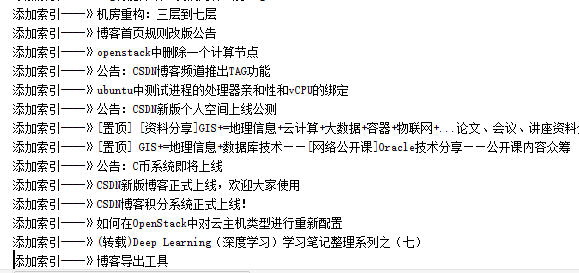前言
为了测试es的完美功能,笔者使用爬虫爬取了Elastic中文社区和CSDN的大量数据,作为测试之用,下面简单介绍一下折腾的过程
认识 WebCollector
WebCollector是一个无须配置、便于二次开发的JAVA爬虫框架(内核),它提供精简的的API,只需少量代码即可实现一个功能强大的爬虫。WebCollector-Hadoop是WebCollector的Hadoop版本,支持分布式爬取。
WebCollector致力于维护一个稳定、可扩的爬虫内核,便于开发者进行灵活的二次开发。内核具有很强的扩展性,用户可以在内核基础上开发自己想要的爬虫。源码中集成了Jsoup,可进行精准的网页解析。2.x版本中集成了selenium,可以处理javascript生成的数据。
官网地址:http://crawlscript.github.io/WebCollector/
使用步骤
导入jar依赖,笔者是maven项目,所有加入如下pom.xml依赖
ps:笔者这里是使用的最新版的,maven仓库目前最新版的是2.09,所以使用最新的就自己下载打包吧
环境有了后,直接新建一个类继承BreadthCrawler类重新visit方法,你的处理逻辑都在visit方法里面,下面楼主贴下我的代码
爬取Elastic中文社区资源
去我博客查看原文 http://www.kailing.pub/article/index/arcid/86.html
下面是导入数据的截图
为了测试es的完美功能,笔者使用爬虫爬取了Elastic中文社区和CSDN的大量数据,作为测试之用,下面简单介绍一下折腾的过程
认识 WebCollector
WebCollector是一个无须配置、便于二次开发的JAVA爬虫框架(内核),它提供精简的的API,只需少量代码即可实现一个功能强大的爬虫。WebCollector-Hadoop是WebCollector的Hadoop版本,支持分布式爬取。
WebCollector致力于维护一个稳定、可扩的爬虫内核,便于开发者进行灵活的二次开发。内核具有很强的扩展性,用户可以在内核基础上开发自己想要的爬虫。源码中集成了Jsoup,可进行精准的网页解析。2.x版本中集成了selenium,可以处理javascript生成的数据。
官网地址:http://crawlscript.github.io/WebCollector/
使用步骤
导入jar依赖,笔者是maven项目,所有加入如下pom.xml依赖
ps:笔者这里是使用的最新版的,maven仓库目前最新版的是2.09,所以使用最新的就自己下载打包吧
环境有了后,直接新建一个类继承BreadthCrawler类重新visit方法,你的处理逻辑都在visit方法里面,下面楼主贴下我的代码
爬取Elastic中文社区资源
/**
* Created by 小陈 on 2016/3/29.
*/
@Component
public class ElasticCrawler extends BreadthCrawler {
@Autowired
IpaDao ipaDao;
public ElasticCrawler() {
super("crawl", true);
/*start page*/
this.addSeed("xxx");
/*fetch url like http://news.hfut.edu.cn/show-xxxxxxhtml*/
this.addRegex("xxx");
/*do not fetch jpg|png|gif*/
this.addRegex("-.*\\.(jpg|png|gif).*");
/*do not fetch url contains #*/
// this.addRegex("-.*#.*");
}
@Override
public void visit(Page page, CrawlDatums next) {
String url = page.getUrl();
String content="";
try {
content = ContentExtractor.getContentByUrl(url);
}catch (Exception e){
e.printStackTrace();
}
/*抽取标题*/
String title=page.getDoc().title();
System.out.println("-------------------->"+title);
if(!title.isEmpty() && ! content.isEmpty()){
Pa pa=new Pa(title,content);
ipaDao.save(pa);//持久化到数据库
}
}/**
* @author kl by 2016/3/29
* @boke www.kailing.pub
*/
@Component
public class CSDNCrawler extends BreadthCrawler {
@Autowired
IpaDao ipaDao;
public CSDNCrawler() {
super("crawl", true);
/*start page*/
this.addSeed("http://blog.csdn.net/.*");//添加种子地址
/*fetch url like http://news.hfut.edu.cn/show-xxxxxxhtml*/
this.addRegex("http://blog.csdn.net/.*/article/details/.*");
/*do not fetch jpg|png|gif*/
this.addRegex("-.*\\.(jpg|png|gif).*");
/*do not fetch url contains #*/
// this.addRegex("-.*#.*");
}
@Override
public void visit(Page page, CrawlDatums next) {
String url = page.getUrl();
String content="";
try {
content = ContentExtractor.getContentByUrl(url);
}catch (Exception e){
e.printStackTrace();
}
if (page.matchUrl("http://blog.csdn.net/.*/article/details/.*")) {
String title = page.select("div[class=article_title]").first().text();
String author = page.select("div[id=blog_userface]").first().text();//获取作者名
System.out.println("title:" + title + "\tauthor:" + author);
if(!title.isEmpty() && ! content.isEmpty()){
Pa pa=new Pa(title,content);
ipaDao.save(pa);
}
}
}去我博客查看原文 http://www.kailing.pub/article/index/arcid/86.html
下面是导入数据的截图
[尊重社区原创,转载请保留或注明出处]
本文地址:http://elasticsearch.cn/article/64
本文地址:http://elasticsearch.cn/article/64
1 个评论
你是怎么保存数据到ES中的



